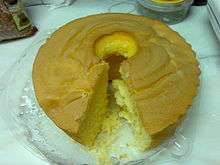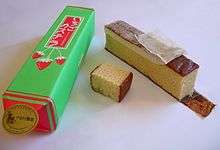Castella
|
| |
| Type | Sponge cake |
|---|---|
| Place of origin | Japan |
| Region or state | Nagasaki |
| Main ingredients | Flour, sugar, eggs, mizuame |
Castella (カステラ Kasutera) is a popular Japanese sponge cake made of sugar, flour, eggs, and starch syrup.
Now a specialty of Nagasaki, the cake was brought to Japan by Portuguese merchants in the 16th century. The name is derived from Portuguese Pão de Castela, meaning "bread from Castile". Castella cake is usually sold in long boxes, with the cake inside being approximately 27 cm long. It is somewhat similar to Madeira cake, also associated with Portugal, but its closest relative is pão-de-ló, also a Portuguese cake.
There are similar types of sponge cakes named after the same fashion, in French: Pain d'Espagne, in Italian: Pan di Spagna, in Portuguese: Pão de Espanha, in Romanian: Pandișpan, in Bulgarian: пандишпан, in Greek: Παντεσπάνι, in Turkish: Pandispanya. (Castile was a former kingdom of Spain, comprising its north-central provinces, thus Pain d'Espagne and other variants are quasi-synonymous to "bread from Castile"). A similar cake, called taisan, is a traditional dessert in Pampanga province in the Philippines.[1]
History



In the 16th century, the Portuguese reached Japan and soon started trade and missionary work. Nagasaki was then the only Japanese port open for foreign commerce. The Portuguese introduced many then-unusual things, such as guns, tobacco, and pumpkins. The cake could be stored for a long period of time, and so was useful for the sailors who were out on the sea for months. In the Edo period, in part due to the cost of sugar, castella was an expensive dessert to make despite the ingredients sold by the Portuguese. When the Emperor of Japan's envoy was invited, the Tokugawa shogunate presented the Castella.[2] Over the years, the taste changed to suit Japanese palates.
Varieties
There are now many varieties made with ingredients such as powdered green tea, brown sugar, and honey. They may be molded in various shapes; a popular Japanese festival food is baby castella, a bite-sized version.
Siberia, castella cake filled with youkan (sweet bean jelly), was popular in the Meiji era; it had a resurgence since it appeared in the 2013 animated film The Wind Rises, by Hayao Miyazaki.[3]
Castella mix is used for the pancakes that are sandwiched together with sweet aduki bean paste in the confection known as dorayaki.
Taiwanese Castella
Castella were first introduced to Taiwan in 1917, during the age of Taiwan under Japanese rule. In 1968, Ye Yongqing, the owner of a Japanese bakery in Taipei named Nanbanto, partnered with the Japanese company Nagasaki Honputo establish Hometown of One, Taiwan’s first shop specializing in castella. This shop adapted the recipe to better suit Taiwanese tastes, creating varieties that incorpoated Taiwanese Longan honey and Japanese cheese. With these changes and with heavy promotion, castella quickly became a favourite amongst the Taiwanese people.[4]
Honey Castella
The most popular variety of castella in Taiwan is Honey Castella. Honey is not a necessary ingredient in the original Japanese recipe, and honey castella are therefore uncommon in Japan. However, in Taiwan, customers prefer this modified version of castella, which has a strong scent of thick honey.
Rock-Baked Castella
Another Taiwanese variety, rock-baked castella is a double-baked cake in a circular shape, with a honey castella base and a cheese-based topping. They are usually more expensive than honey castella.
See also
References
- ↑ https://salu-salo.com/taisan-filipino-chiffon-cake/
- ↑ Bunmeidou History of Castella Archived June 22, 2008, at the Wayback Machine.
- ↑ "The old-timey treat that's back in style thanks to Hayao Miyazaki". RocketNews24. 2013-09-08. Retrieved 2017-01-08.
- ↑ Official site of Nanbanto. 2018.
External links
| Wikimedia Commons has media related to Castella (food). |
